CHEVROLET S10 1995 2.G Manual PDF
Manufacturer: CHEVROLET, Model Year: 1995, Model line: S10, Model: CHEVROLET S10 1995 2.GPages: 354, PDF Size: 18.92 MB
Page 71 of 354
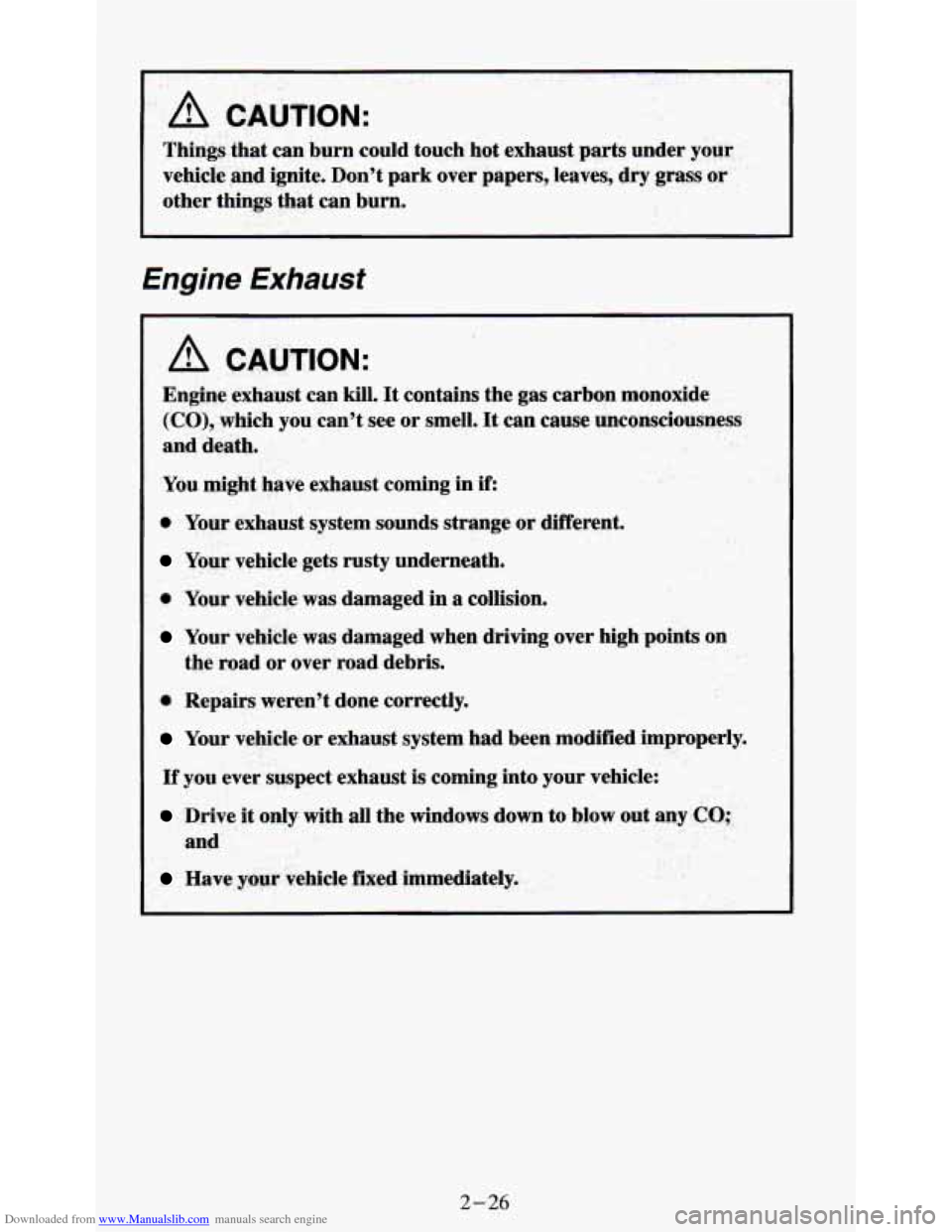
Downloaded from www.Manualslib.com manuals search engine Things that can burn could touch hot exhaust parts under your
vehicle and ignite. Don’t park over papers, leaves, dry grass
or
other things that can burn.
Engine Exhaust
A CAUTION:
Engine exhaust can kill. It contains the gas carbon monoxide
(CO), which you can’t see or smell. It can cause unconsciousness
and death.
You might have exhaust coming in
if:
0 Your exhaust system sounds strange or different.
Your vehicle gets rusty underneath.
0 Your vehicle was damaged in a collision.
Your vehicle was damaged when driving over high points on
the road or over road debris.
0 Repairs weren’t done correctly.
Your vehicle or exhaust system had been modified improperly.
If you ever suspect exhaust is coming into your vehicle:
Drive it only with all the windows down to blow out any CO;
and
Have your vehicle fixed immediately.
2-26
Page 72 of 354
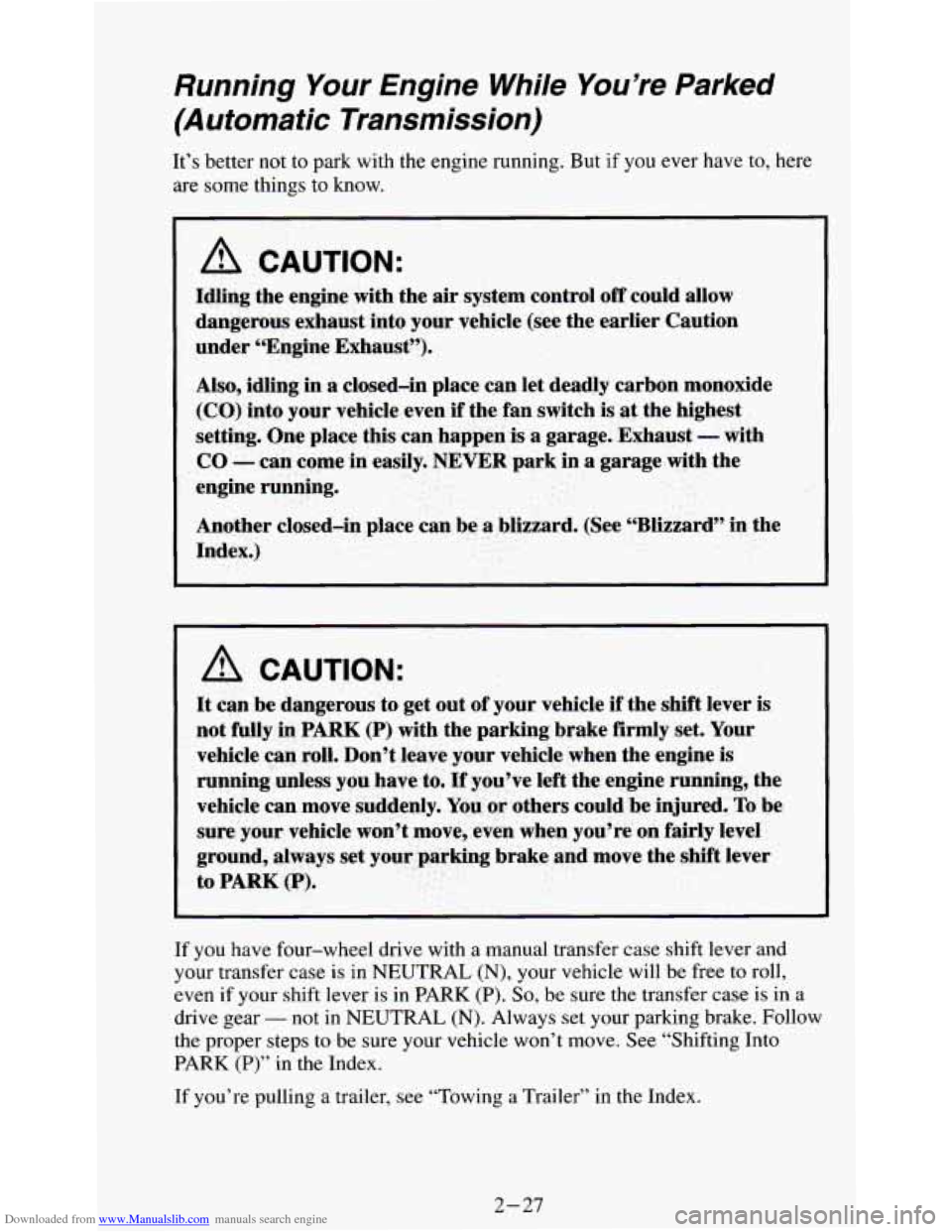
Downloaded from www.Manualslib.com manuals search engine Running Your Engine While You’re Parked
(Automatic Transmission)
It’s better not to park with the engine running. But if you ever have to, here
are some things to know.
A CAUTION:
_-i . ..
If you have four-wheel drive with a manual transfer case shift lever and
your transfer case is in NEUTRAL (N), your vehicle will be free to roll,
even
if your shift lever is in PARK (P). So, be sure the transfer case is in a
drive gear
- not in NEUTRAL (N). Always set your parking brake. Follow
the proper steps to be sure your vehicle won’t move. See “Shifting Into
PARK
(P)” in the Index.
If you’re pulling a trailer, see “Towing a Trailer”
in the Index.
2-27
Page 73 of 354
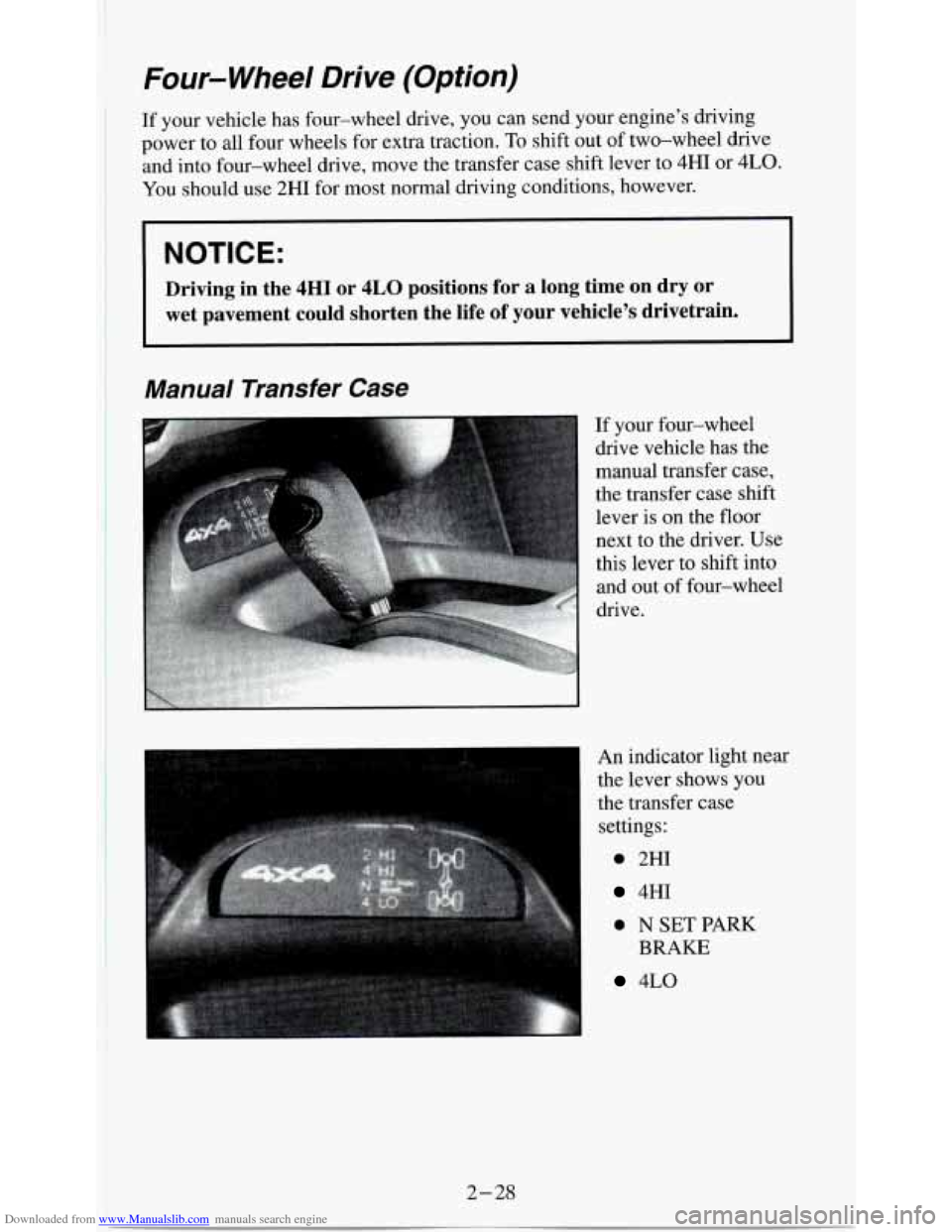
Downloaded from www.Manualslib.com manuals search engine Four- Wheel Drive (Option)
If your vehicle has four-wheel drive, you can send your engine’s driving
power to all four wheels for extra traction.
To shift out of two-wheel drive
and into four-wheel drive, move the transfer case shift lever to
4HI or 4LO.
You should use 2HI for most normal driving conditions, however.
NOTICE:
Driving in the 4HI or 4LO positions for a long time on dry or
wet pavement could shorten the life
of your vehicle’s drivetrain.
Manual Transfer Case
If your four-wheel
drive vehicle has the
manual transfer case,
the transfer case shift
lever is
on the floor
An indicator light near
the lever
shows you
the transfer case
settings:
0 2HI
4HI
0 N SET PARK
4LO
BRAKE
Page 74 of 354
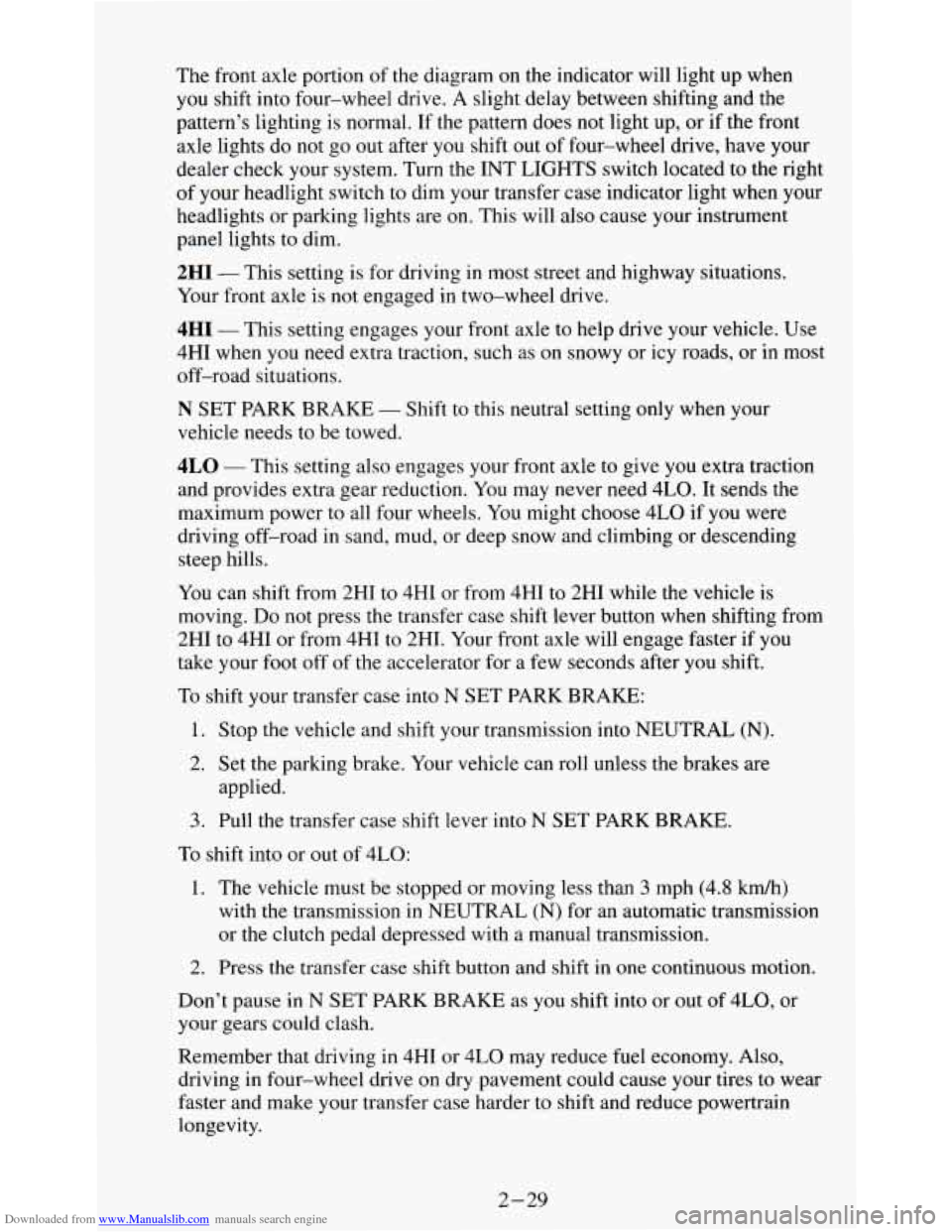
Downloaded from www.Manualslib.com manuals search engine The front axle portion of the diagram on the indicator will light up when
you shift into four-wheel drive. A slight delay between shifting and the
pattern’s lighting is normal. If the pattern does not light up, or
if the front
axle lights do not go out after you shift out of four-wheel drive, have your
dealer check your system. Turn the INT LIGHTS switch located to the right
of your headlight switch
to dim your transfer case indicator light when your
headlights or parking lights are
on. This will also cause your instrument
panel lights to dim.
2HI - This setting is for driving in most street and highway situations.
Your front axle is not engaged in two-wheel drive.
4HI - This setting engages your front axle to help drive your vehicle. Use
4HI when you need extra traction, such as on snowy or icy roads, or in most
off-road situations.
N SET PARK BRAKE - Shift to this neutral setting only when your
vehicle needs to be towed.
4LO - This setting also efigziges your front axle to give you extra traction
and provides extra gear reduction. You may never need 4LO. It
sends the
maximum power to all four wheels. You might choose 4LO if you were
driving off-road in sand, mud, or deep snow and climbing or descending
steep hills.
You can shift from 2HI to 4HI
or from 4HI to 2HI while the vehicle is
moving.
Do not press the transfer case shift lever button when shifting from
2HI to
4HI or from 4HI to 2HT. Your front axle will engage faster if you
take your foot off of the accelerator for a few seconds after you shift.
To shift your transfer case into N SET PARK BRAKE:
1. Stop the vehicle and shift your transmission into NEUTRAL
(N).
2. Set the parking brake. Your vehicle can roll unless the brakes are
applied.
3. Pull the transfer case shift lever into N SET PARK BRAKE.
To shift into or out of 4LO:
1. The vehicle must be stopped or moving less than 3 mph (4.8 km/h)
with the transmission in NEUTRAL
(N) for an automatic transmission
or the clutch pedal depressed with a manual transmission.
2. Press the transfer case shift button and shift in one continuous motion.
Don’t pause in
N SET PARK BRAKE as you shift into or out of 4L0, or
your gears could clash.
Remember that driving in 4HI or 4LO may reduce fuel economy. Also,
driving in four-wheel drive
on dry pavement could cause your tires to wear
faster and make your transfer case harder to shift and reduce powertrain
longevity.
2-29
Page 75 of 354
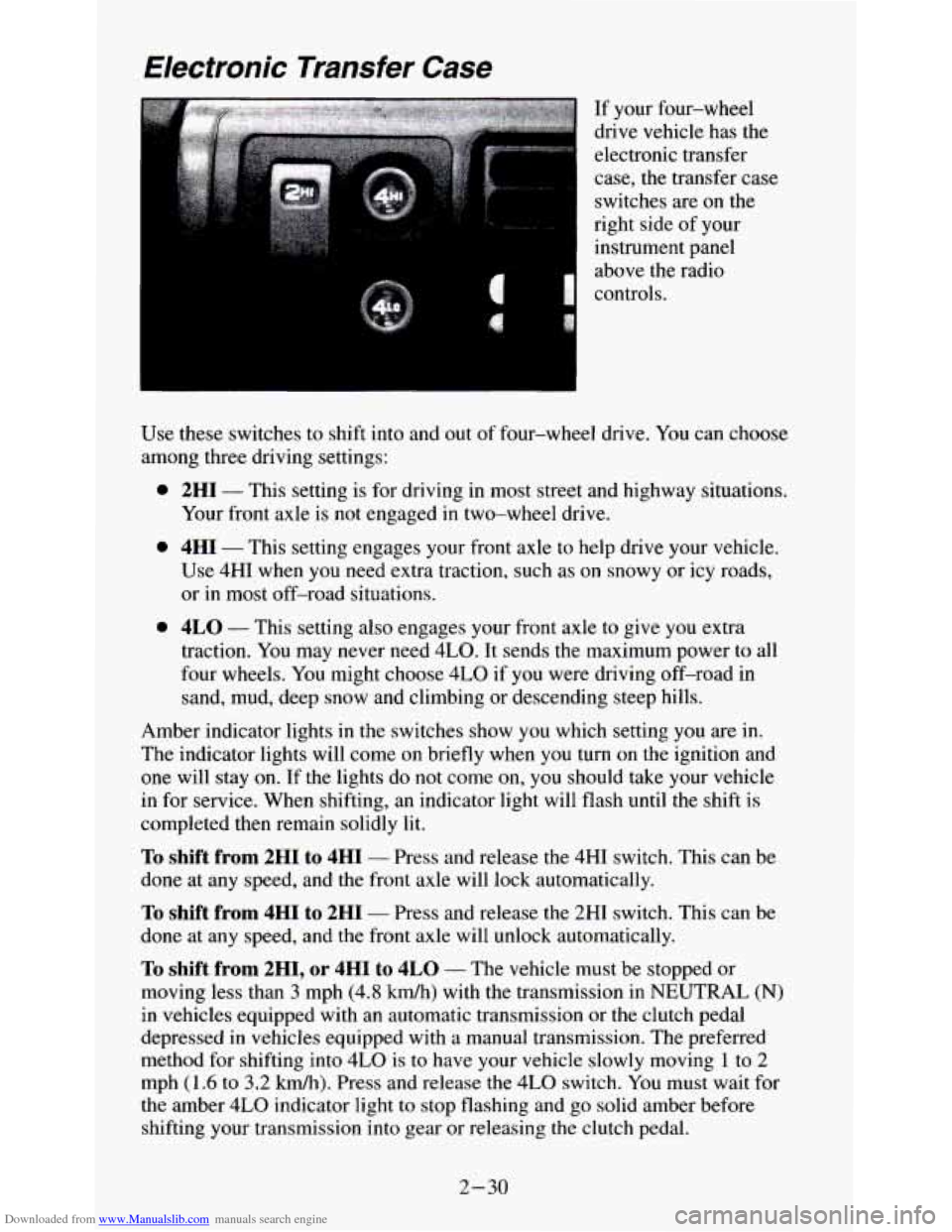
Downloaded from www.Manualslib.com manuals search engine Use these switches to shift into and out of four-wheel drive. You can choose
among three driving settings:
0
0
0
2HI - This setting is for driving in most street and highway situations.
Your front axle
is not engaged in two-wheel drive.
4HI - This setting engages your front axle to help drive your vehicle.
Use 4HI when you need extra traction, such as
on snowy or icy roads,
or
in most off-road situations.
4LO - This setting also engages your front axle to give you extra
traction. You may never need
4LO. It sends the maximum power to all
four wheels. You might choose
4LO if you were driving off-road in
sand, mud, deep snow and climbing or descending steep hills.
Amber indicator lights
in the switches show you which setting you are in.
The indicator lights will come on briefly when you turn on the ignition and
one will stay
on. If the lights do not come on, you should take your vehicle
in for service. When shifting, an indicator light will flash until the shift is
completed then remain solidly lit.
To shift from 2HI to 4HI - Press and release the 4HI switch. This can be
done at any speed, and the front axle will lock automatically.
To shift from 4HI to 2HI - Press and release the 2HI switch. This can be
done at any speed, and the front axle will unlock automatically.
To shift from 2H1, or 4HI to 4LO - The vehicle must be stopped or
moving less than
3 mph (4.8 km/h) with the transmission in NEUTRAL (N)
in vehicles equipped with an automatic transmission or the clutch pedal
depressed
in vehicles equipped with a manual transmission. The preferred
method for shifting into
4LO is to have your vehicle slowly moving 1 to 2
mph (1.6 to 3.2 kdh). Press and release the 4LO switch. You must wait for
the amber
4LO indicator light to stop flashing and go solid amber before
shifting your transmission into gear or releasing
the clutch pedal.
2-30
Page 76 of 354
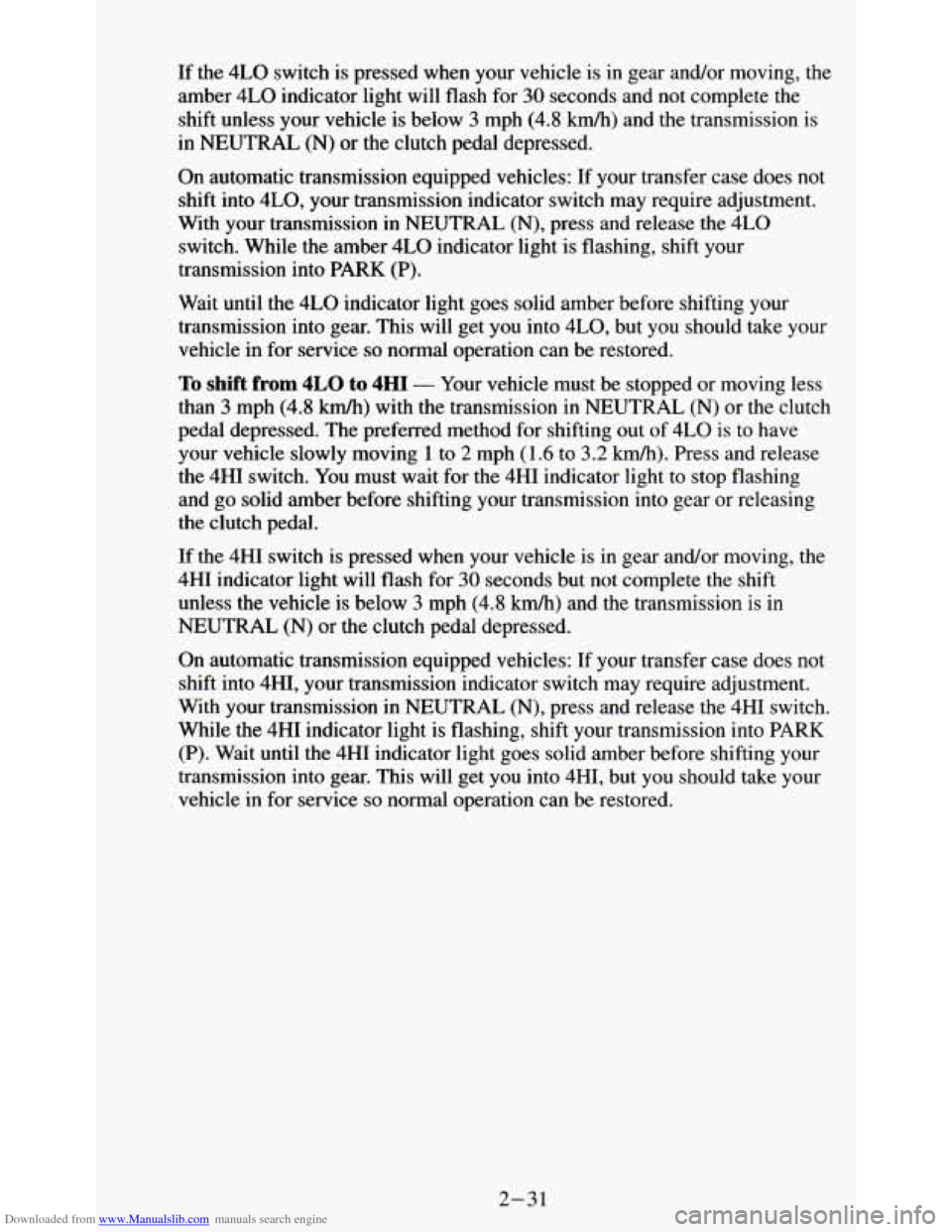
Downloaded from www.Manualslib.com manuals search engine If the 4LO switch is pressed when your vehicle is in gear and/or moving, the
amber
4LO indicator light will flash for 30 seconds and not complete the
shift unless your vehicle is below
3 mph (4.8 km/h) and the transmission is
in
NEUTRAL (N) or the clutch pedal depressed.
On automatic transmission equipped vehicles:
If your transfer case does not
shift into
4L0, your transmission indicator switch may require adjustment.
With your transmission in
NEUTRAL (N), press and release the 4LO
switch. While the amber 4LO indicator light is flashing, shift your
transmission into
PARK (P).
Wait until the 4LO indicator light goes solid amber before shifting your
transmission into gear. This will get you into
4L0, but you should take your
vehicle in for service
so normal operation can be restored.
To shift from 4LO to 4HI - Your vehicle must be stopped or moving less
than
3 mph (4.8 km/h) with the transmission in NEUTRAL (N) or the clutch
pedal depressed. The preferred method for shifting out of
4LO is to have
your vehicle slowly moving
1 to 2 mph ( 1.6 to 3.2 km/h). Press and release
the
4HI switch. You must wait for the 4HI indicator light to stop flashing
and go solid amber before shifting your transmission into gear or releasing
the clutch pedal.
If the
4HI switch is pressed when your vehicle is in gear and/or moving, the
4HI indicator light will flash for 30 seconds but not complete the shift
unless the vehicle is below
3 mph (4.8 kmh) and the transmission is in
NEUTRAL (N) or the clutch pedal depressed.
On automatic transmission equipped vehicles:
If your transfer case does not
shift into
4H1, your transmission indicator switch may require adjustment.
With your transmission
in NEUTRAL (N), press and release the 4HI switch.
While the
4HI indicator light is flashing, shift your transmission into PARK
(P). Wait until the 4HI indicator light goes solid amber before shifting your
transmission into gear. This will get you into
4H1, but you should take your
vehicle in for service
so normal operation can be restored.
2-31
Page 77 of 354
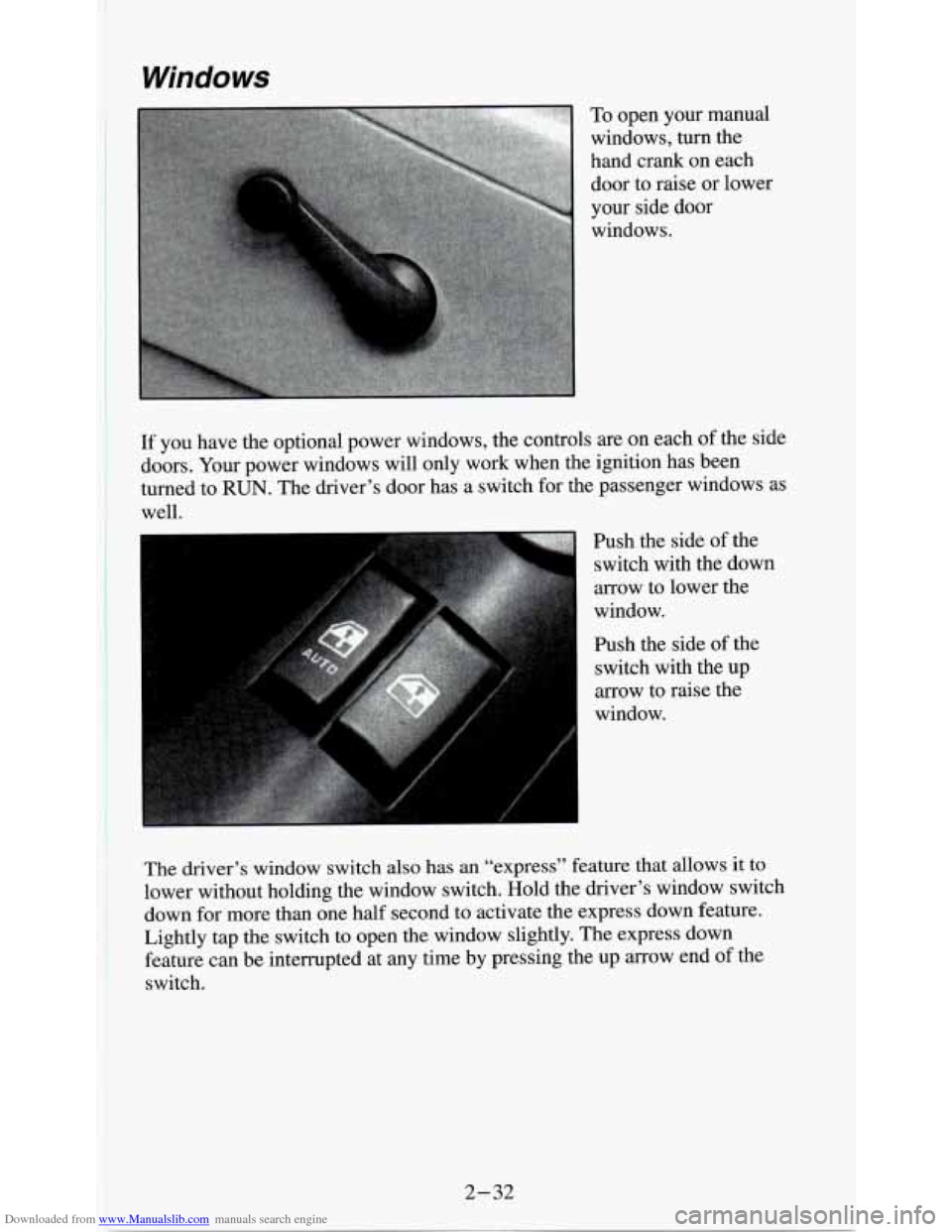
Downloaded from www.Manualslib.com manuals search engine Windows
To open your manual
windows, turn the
hand crank on each door to raise or lower
your side door windows.
Push the side of the
switch with the down
arrow to lower the
window.
Push the side of
the
switch with the up
arrow to raise the
window.
The driver’s window switch also has an “express” feature that allows
it to
lower without holding the window switch. Hold the driver’s window switch
down for more than one half second to activate the express down feature.
Lightly tap the switch
to open the window slightly. The express down
feature can be interrupted at any time by pressing the up arrow end of the
switch.
Page 78 of 354
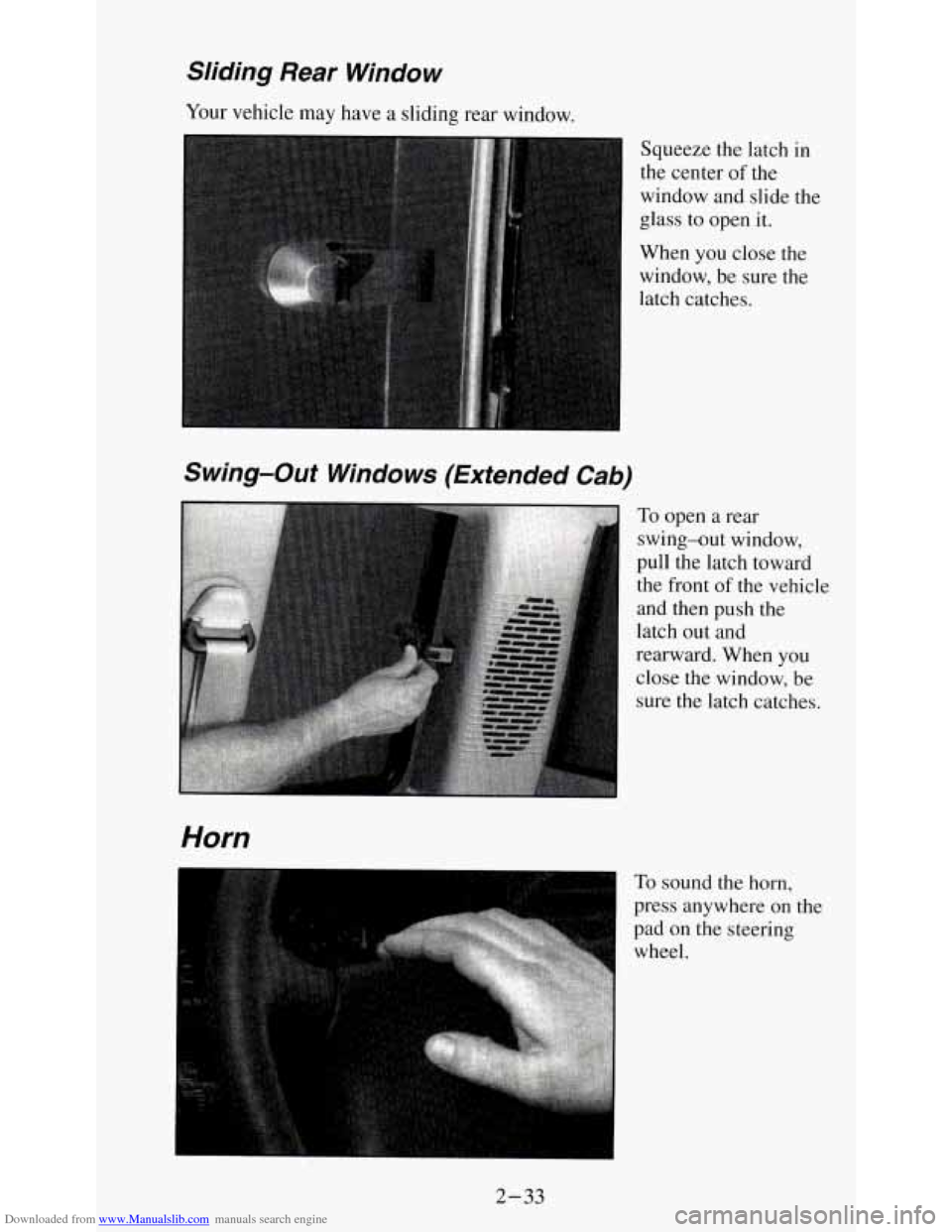
Downloaded from www.Manualslib.com manuals search engine Sliding Rear Window
Your vehicle may have a sliding rear window.
Squeeze the latch in
the center
of the
window and slide the
glass
to open it.
When you close the
window,
be sure the
latch catches.
Swing-Out Windows (Extended Cab)
To open a rear
swing-out window,
pull the latch toward
the front
of the vehicle
and then push the
latch out and
rearward. When you close the window, be
sure the latch catches.
Horn
' To sound the horn,
press anywhere on the
pad
on the steering
wheel.
2-33
Page 79 of 354
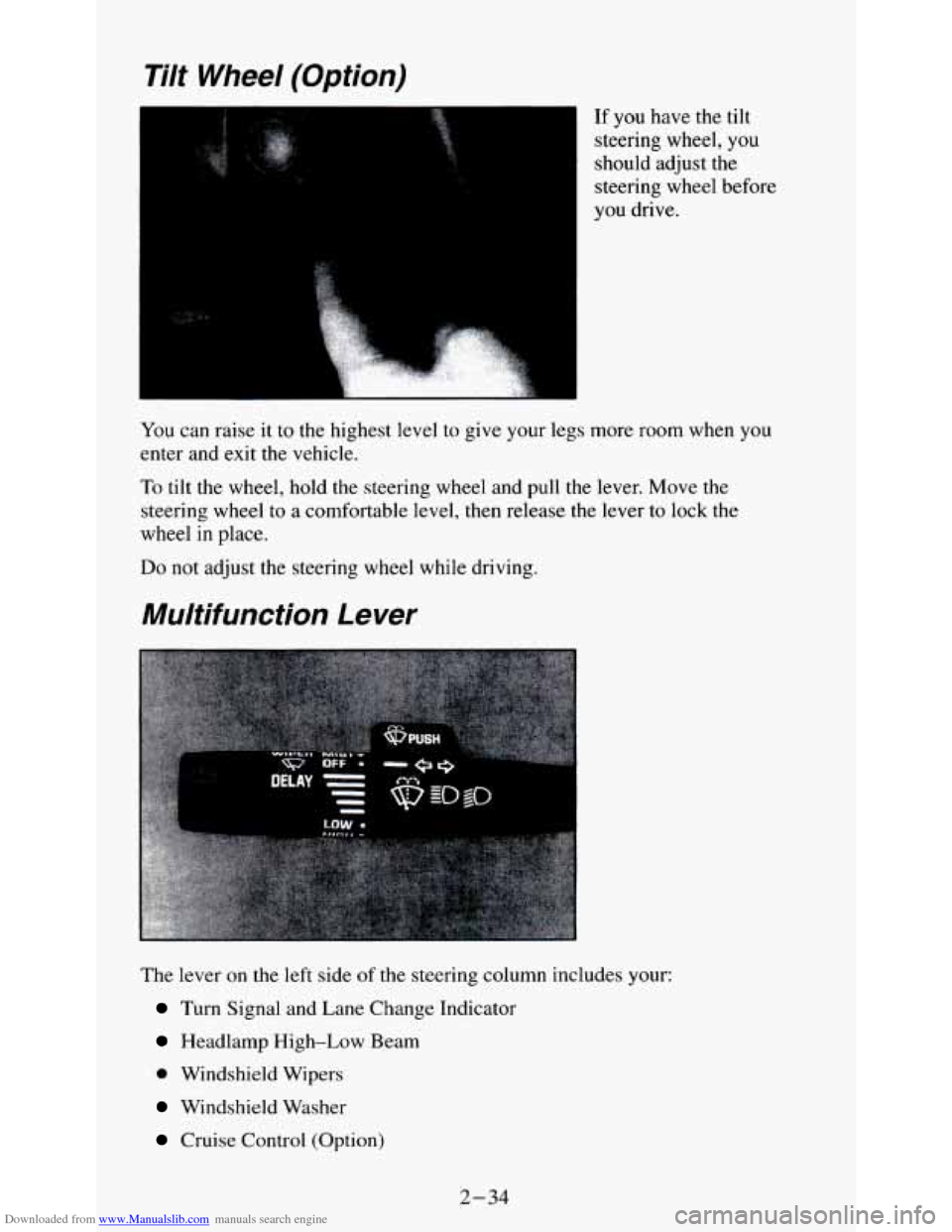
Downloaded from www.Manualslib.com manuals search engine Tilt Wheel (Option)
I
I
If you have the tilt
steering wheel,
you
should adjust the
steering wheel before
you drive.
You can raise it
to the highest level to give your legs more room when you
enter and exit the vehicle.
To tilt the wheel, hold the steering wheel and pull the lever. Move the
steering wheel to a comfortable level, then release the lever to lock the
wheel in place.
Do not adjust the steering wheel while driving.
Multifunction Lever
The lever on the left side of the steering column includes your:
Turn Signal and Lane Change Indicator
Headlamp High-Low Beam
0 Windshield Wipers
Windshield Washer
Cruise Control (Option)
2-34
Page 80 of 354
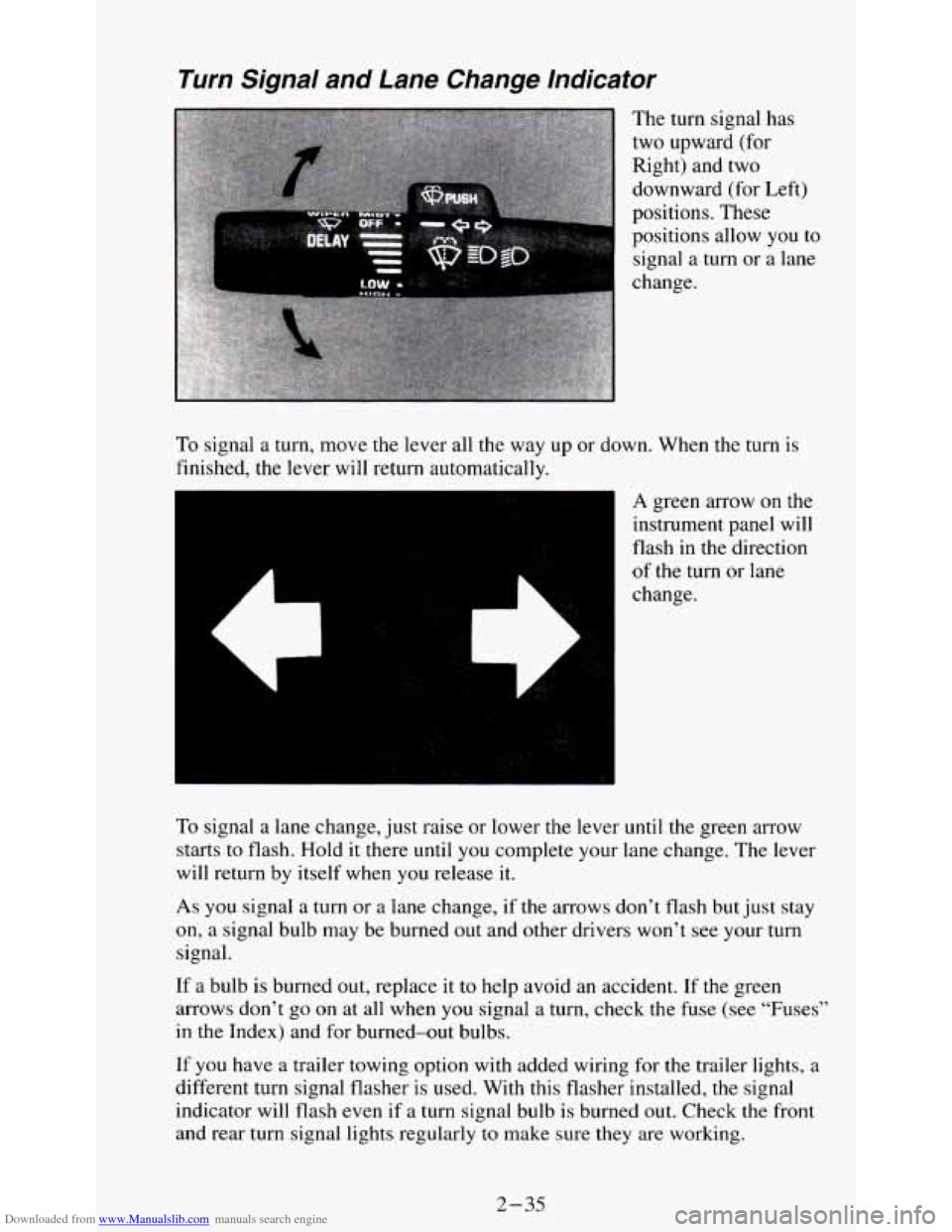
Downloaded from www.Manualslib.com manuals search engine Turn Signal and Lane Change Indicator
The turn signal has
two upward (for
Right) and two
downward (for Left)
positions. These
positions allow you
to
signal a turn or a lane
change.
To signal a turn, move the lever all the way up or down. When the turn is
finished, the lever will return automatically.
es
A green arrow on the
instrument panel will
flash in the direction
of the turn or lane
change.
To signal a lane change, just raise or lower the lever
until the green arrow
starts
to flash. Hold it there until you complete your lane change. The lever
will return by itself when
you release it.
As you signal a turn or a lane change, if the arrows don’t flash but just stay
on, a signal bulb may be burned out and other drivers won’t see your turn
signal.
If a bulb is burned out, replace it to help avoid an accident. If the green
arrows don’t go on at all when
you signal a turn, check the fuse (see “Fuses”
in the Index) and for burned-out bulbs.
If you have a trailer towing option with added wiring for the trailer lights, a
different turn signal flasher is used. With this flasher installed, the signal
indicator will flash even
if a turn signal bulb is burned out. Check the front
and rear turn signal lights regularly
to make sure they are working.
2-35